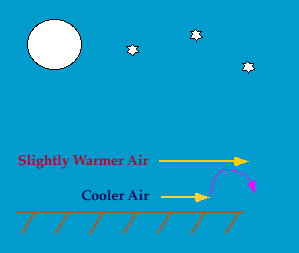|
|
. |
Effects of Wind
on forecasted temperatures
At night, the earth's surface cools by radiating heat off to space.
The strongest cooling takes place right near the surface while
temperatures at roughly 3000 feet are actually warmer than those at
the surface.
On a windy night, some
of the warmer air aloft is mixed down towards
the surface. This occurs because the
winds are faster aloft than at the surface.
To visualize this, place one hand over the other about six inches apart.
The bottom hand represents the air near the surface and the top hand
represents the warmer wind higher up. Move the bottom hand slowly
and the upper hand faster (to indicate the faster winds aloft).
The faster air above and slower air below causes the air to overturn or spin
(as in the picture below). This overturning motion is how warmer
air from above is transported downward on windy nights.

Forecast Tip:
On a calm night, the maximum surface cooling can take place. But on a
windy night, some warmer air is mixed downward to the surface, which
prevents the temperatures from droping as quickly as they would on a clear
night. Therefore, forecast slightly warmer temperatures for a windy night
than for a calm night.

snow cover
|
|

Precipitation
|
|


